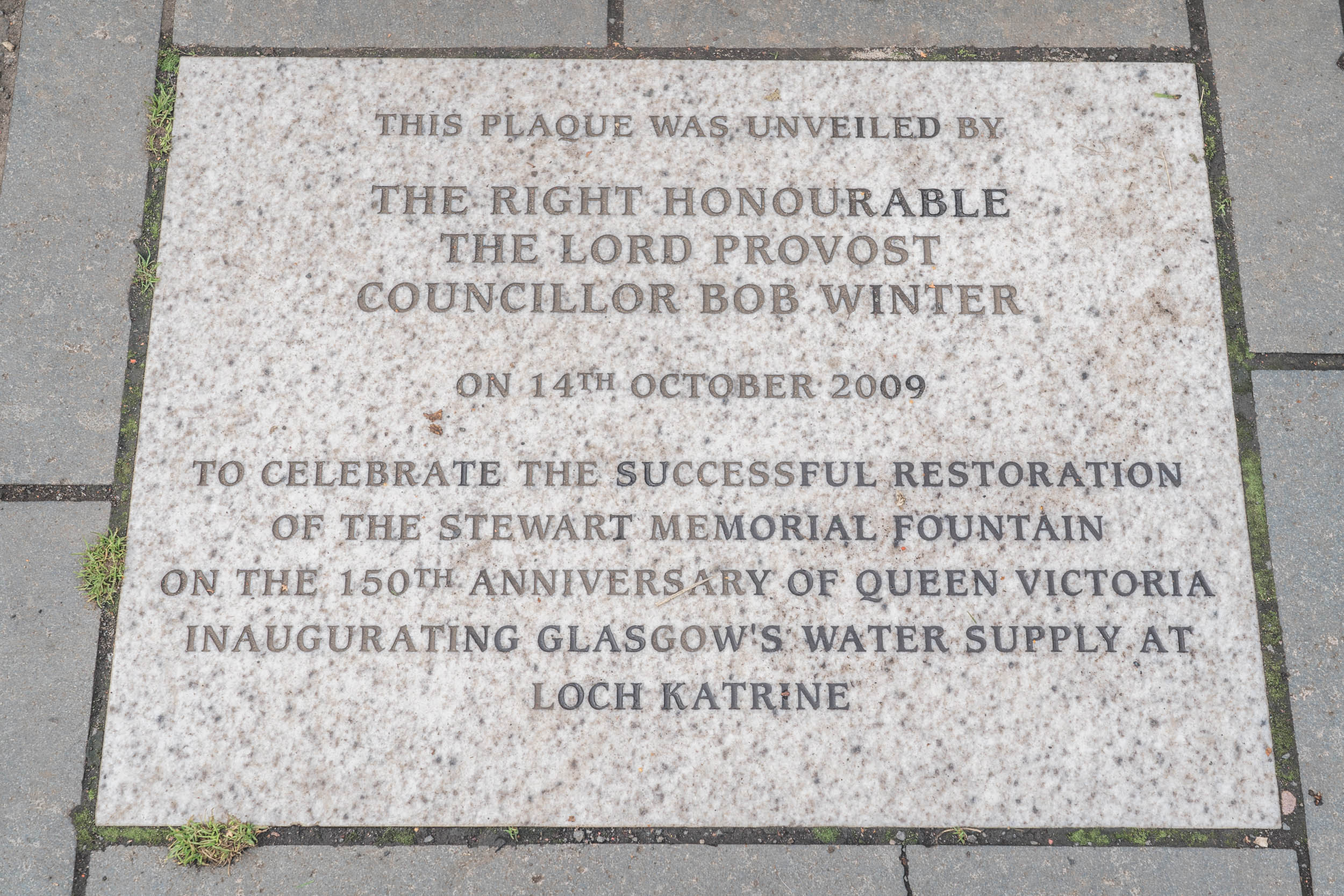Loch Katrine Waterworks
This guide tells the story of the Loch Katrine waterworks and their transformational effect on the health of Scotland’s largest city in the late 1850s. The picture above is an information board we helped write to celebrate the legacy found at Stronachlachar Pier, close to the aqueduct system. We were also involved in the 2019 event to commemorate the 160th anniversary of the system. We will share some pictures of the reenactment of the historic opening of the waterworks by Queen Victoria in 1859.
A Victorian Feat of Engineering
The Loch Katrine Aqueduct is one of Scotland’s most significant engineering achievements, bringing fresh water from Loch Katrine to Glasgow. The renowned engineer John F. Bateman designed this monumental project to address Glasgow’s growing health crisis in the 19th century.
Two devastating cholera outbreaks in the first half of the century highlighted the need for a clean water supply. Previously reliant on wells and streams, Glasgow’s citizens suffered from poor sanitation and waterborne diseases. The aqueduct system opened in 1859 and was a turning point, carrying clean water over 26 miles to the city.
How the System Works
The Loch Katrine Aqueduct uses gravity to transport water from the loch to treatment works in Milngavie and Balmore through tunnels, bridges, and reservoirs, with water flowing steadily with a fall of just ten inches per mile, an ingenious solution. The system spans 26 miles, navigating mountainous terrain and river valleys. A second aqueduct was later added to meet the demands of Glasgow’s growing population.
The water journey takes approximately 14 hours, ensuring a steady, clean water supply to millions of residents. This efficient and sustainable design continues to serve as a worldwide model for modern water systems. The Katrine Aqueduct scheme cost £3.2m to build, which would be about £320m at today’s prices.
The Importance of the Aqueduct
The aqueduct was a triumph of Victorian engineering and a lifesaving innovation. The system replaced contaminated water sources with a reliable supply, significantly improving public health. The aqueduct remains operational today, delivering water to over 1.3 million people in Greater Glasgow and beyond. Its importance cannot be overstated; this infrastructure helped Glasgow grow into a thriving industrial and cultural hub, earning its nickname as the “Second City of the Empire.”
Loch Katrine Waterworks Location
The red marker on the map shows the waterworks' location, which is pointed out during the live onboard commentary on the twice daily sailings of the Steamship Sir Walter Scott, which 2025 celebrates her 125th anniversary. Below, you can see a close-up of the system's top from the water.
Queen Victoria’s Visit and Dedication
The aqueduct’s opening was a momentous occasion, marked by the presence of Queen Victoria, Prince Albert, and their daughters, Princesses Alice and Helena. On a wet October day in 1859, the royal party travelled aboard the Rob Roy steamship to inaugurate the project.
Thousands gathered at Loch Katrine despite terrible weather, trekking across hills to witness the historic event. Queen Victoria opened a sluice with a silver handle during the ceremony and expressed her admiration for the project. Her speech celebrated the aqueduct’s impact on Glasgow’s health and prosperity.
The event was not without its challenges. The 21-gun salute in her honour shattered the windows of the Royal Cottage, which had been prepared for her stay. Nevertheless, the Queen’s connection to Loch Katrine endured. She returned to the region several times, captivated by its dramatic landscapes and inspired by the works of Sir Walter Scott, whose novel Rob Roy and poem Lady of the Lake immortalised the area.
Marketing Services
Video, Photography & Websites
Celebrating 160 Years
In 2019, the 160th anniversary of the aqueduct’s opening was commemorated with special events at Loch Katrine. Passengers aboard the Sir Walter Scott Steamship and the Lady of the Lake cruise boats were joined by actors portraying Queen Victoria and Prince Albert. Dressed in Victorian costumes, they recreated the historic scene, including the Queen’s original speech, which praised the aqueduct’s transformative impact. Here’s an extract from the monarch’s speech.
“It is with much gratification that I avail myself of this opportunity of inaugurating a work which, both in its conception and its execution, reflects so much credit on its promoters, and is so calculated to improve the health and comfort of your vast population, which is rapidly increasing round the great centre of manufacturing industry in Scotland.
Such work is worthy of the enterprise and philanthropy of Glasgow, and I trust it will be blessed with complete success. I desire that you convey to the great community which you represent my warmest wishes for their continued prosperity and happiness.”
Queen Victoria’s Love for the Highlands
Queen Victoria’s connection to Loch Katrine was part of her broader affection for Scotland’s Highlands. Her visits to the region were chronicled in her diaries, Leaves from a Journal of Our Life in the Highlands and More Leaves. These writings vividly describe her travels, including her intimate 1869 visit to Invertrossachs near Loch Venachar.
On this private trip, she enjoyed the rugged beauty of the Trossachs, visiting places like Queen’s View and Aberfoyle. Her diary entries reveal a mix of admiration for the landscapes and relatable anecdotes about unpredictable weather. The Queen’s enthusiasm for Scotland helped popularize the region as a tourist destination, inspiring countless travellers to explore the Highlands.
Royal Inspiration and Cultural Legacy
Queen Victoria’s visits to Loch Katrine and the Trossachs reinforced her love for Scotland and brought attention to the region’s natural beauty and cultural heritage. Her sketches and diary entries from the Rob Roy steamer reveal her admiration for the scenery. The era's writers, poets, and painters followed her lead, drawing inspiration from these landscapes.
Her connection to Loch Katrine extended beyond the aqueduct’s opening. She returned to the area during more favourable weather, enjoying its serene lochs and majestic hills. Her legacy lives on in the region’s popularity as a destination for history enthusiasts and nature lovers.
Heritage Legacy
The Loch Katrine Aqueduct is a monumental achievement in Victorian engineering, transforming Glasgow’s health and infrastructure. Queen Victoria’s role in its history adds a royal touch to its story, intertwining the grandeur of the monarchy with the practical benefits of clean water.
Today, the aqueduct continues to inspire, not just as a feat of engineering but as a reminder of the vision and determination of those who built it whether visiting Loch Katrine to learn about its history or to admire its beauty, the legacy of this extraordinary project remains as vibrant as ever.
Purchase a See Loch Lomond T-Shirt
Kelvingrove Park’s Fountain
The Gothic fountain in Kelvingrove Park, Glasgow, is an iconic symbol of the aqueduct’s impact. Erected in 1871, the fountain honours Robert Stewart, a key figure in the project. Its carvings depict scenes from the Trossachs and pay tribute to Sir Walter Scott’s literary works. Restored for the 150th anniversary, the fountain is a testament to the aqueduct’s importance in Glasgow’s history.
The Full Range of Loch Katrine Guides
This See Loch Lomond website features many helpful guides to help you make the most of your visit to Loch Katrine, and I’ve linked to them all here:
Start with the main guide, which covers the full range of activities and experiences. For a deeper dive, explore Stronachlachar and its tranquil charm, or learn about the Victorian waterworks opened by Queen Victoria in 1859. Discover the Roderick Dhu Path, complete with a viewpoint and Scenic Tower, or immerse yourself in the history of the Steamship Sir Walter Scott with timetables and fascinating details. Plan a scenic drive along the Trossachs Trail, a 40-mile route that takes in Loch Katrine, and delve into the life and legacy of Rob Roy MacGregor, the legendary figure born at Loch Katrine. These guides offer everything you need to plan an unforgettable visit.
Have a wonderful visit to Loch Katrine, and let me know about your time in one of Scotland’s most beautiful lochs in the comments below.
Thanks for reading
Words and photography by Paul Saunders. Visit Paul’s Marketing and Photography websites for details of his services in Scotland.
Please let us know if you found the guide helpful in the comments section below.













Buy our guidebook, 101 Things to Do in Loch Lomond and the Trossachs, packed with attractions, views, and activities to enjoy.